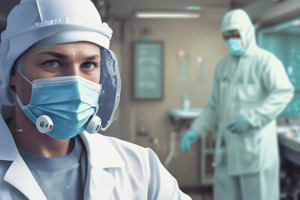Podcast
Questions and Answers
What is the purpose of taking a detailed history in a patient with an infection?
What is the purpose of taking a detailed history in a patient with an infection?
- To determine the severity of the infection
- To gather information about the patient's symptoms, environment, and contacts (correct)
- To rule out other possible diagnoses
- To identify the causative microorganism
What is the primary function of interleukin 1 in the body's response to infection?
What is the primary function of interleukin 1 in the body's response to infection?
- To trigger the release of white blood cells
- To stimulate the production of C-reactive protein
- To increase the body's temperature (correct)
- To activate the immune system's response to infection
Which of the following microorganisms is typically transmitted through insects?
Which of the following microorganisms is typically transmitted through insects?
- Malaria (correct)
- E. coli
- Hepatitis A
- SARS-CoV-2
What is a common symptom of a chest infection such as pneumonia?
What is a common symptom of a chest infection such as pneumonia?
What is the purpose of a Gram stain in the diagnosis of bacterial infections?
What is the purpose of a Gram stain in the diagnosis of bacterial infections?
Which of the following is a marker of infection and inflammation?
Which of the following is a marker of infection and inflammation?
What is the primary function of interleukin 6 in the body's response to infection?
What is the primary function of interleukin 6 in the body's response to infection?
What is the primary mode of transmission for the disease cholera?
What is the primary mode of transmission for the disease cholera?
What type of immunisation is achieved through immunoglobulins from human serum?
What type of immunisation is achieved through immunoglobulins from human serum?
Which of the following is a symptom of a skin infection such as cellulitis?
Which of the following is a symptom of a skin infection such as cellulitis?
What is the primary function of a white blood cell count in the diagnosis of infection?
What is the primary function of a white blood cell count in the diagnosis of infection?
What is the primary cause of SARS?
What is the primary cause of SARS?
Which of the following vaccines is an example of a non-replicating viral vector?
Which of the following vaccines is an example of a non-replicating viral vector?
What is the primary mode of transmission of SARS?
What is the primary mode of transmission of SARS?
What is the main difference between passive immunisation and active immunisation?
What is the main difference between passive immunisation and active immunisation?
Which of the following vaccines is an example of an inactivated virus particle?
Which of the following vaccines is an example of an inactivated virus particle?
What is the primary cause of MERS?
What is the primary cause of MERS?
What is the purpose of Koch's postulates?
What is the purpose of Koch's postulates?
What is the main advantage of passive immunisation?
What is the main advantage of passive immunisation?
How many vaccines were in early pre-clinical development against SARS-CoV-2?
How many vaccines were in early pre-clinical development against SARS-CoV-2?
What is the primary purpose of a blood culture in investigating infections?
What is the primary purpose of a blood culture in investigating infections?
Which of the following investigations is commonly used in chest infections and TB?
Which of the following investigations is commonly used in chest infections and TB?
What is the primary purpose of quarantine in infection control?
What is the primary purpose of quarantine in infection control?
Which of the following tests is commonly used to diagnose hepatitis?
Which of the following tests is commonly used to diagnose hepatitis?
What is the primary purpose of hand hygiene in infection control?
What is the primary purpose of hand hygiene in infection control?
Which of the following investigations is commonly used to diagnose viral infections?
Which of the following investigations is commonly used to diagnose viral infections?
What is the primary purpose of ethical dilemmas in infection control?
What is the primary purpose of ethical dilemmas in infection control?
Which of the following is a general public health measure in infection control?
Which of the following is a general public health measure in infection control?
What is the primary purpose of CT scans in investigating infections?
What is the primary purpose of CT scans in investigating infections?
Which of the following is a limitation of quarantine in infection control?
Which of the following is a limitation of quarantine in infection control?
Flashcards
Disease-Causing Microorganisms
Disease-Causing Microorganisms
Microorganisms including bacteria, viruses, fungi, protozoa, helminths (worms), and prions that can cause disease.
SARS Transmission
SARS Transmission
Spread through respiratory droplets from coughs and sneezes
MERS Transmission
MERS Transmission
Caused by direct or indirect contact with infected dromedary camels
Passive Immunization
Passive Immunization
Signup and view all the flashcards
Key History-Taking Elements
Key History-Taking Elements
Signup and view all the flashcards
Markers of Infection
Markers of Infection
Signup and view all the flashcards
White Blood Cell Count
White Blood Cell Count
Signup and view all the flashcards
C-Reactive Protein (CRP)
C-Reactive Protein (CRP)
Signup and view all the flashcards
Tests for Bacterial Infections
Tests for Bacterial Infections
Signup and view all the flashcards
Tests for Viral Infections
Tests for Viral Infections
Signup and view all the flashcards
Infection Control Measures
Infection Control Measures
Signup and view all the flashcards
Ethical Issues in Infection Control
Ethical Issues in Infection Control
Signup and view all the flashcards
Study Notes
Microorganisms Causing Disease
- Bacteria, viruses, fungi, protozoa, helminths (worms), and prions can cause disease
Transmission of Infection
- Person to person: influenza, SARS-CoV-2, EBV, HIV
- Water: cholera, Hepatitis A
- Food: E. coli, salmonella
- Insects: Malaria
- Surface: MRSA
History Taking
- Importance of taking detailed history:
- Symptoms
- Time since first exposure
- Contacts (including sexual partners, animals)
- Environment (damp building, air conditioner, overcrowding)
- Food/drink
- Travel
Markers of Infection
- Rise in temperature (in some cases, temperature may go down)
- Interleukin 1 tells the brain to increase the temperature
- General malaise (lethargy, body ache, head ache, loss of appetite, influenza, etc.)
- Pain (general muscle pain in many infections, abdominal pain in hepatitis, abdomen tender to touch, etc.)
- Breathlessness (chest infection including pneumonia)
- Local skin changes:
- Impetigo: blisters and sores on the skin
- Cellulitis: redness, heat, pain at the site of infection
- Necrotising fasciitis: deep skin infection
- Cough:
- Dry cough (e.g., whooping cough)
- Productive cough: purulent sputum (e.g., tuberculosis)
- Confusion (meningitis, sepsis, etc.)
General Tests for Infection
- White blood cell count: generally increases in infection, but may decrease in some cases (e.g., CD4+ cells in HIV)
- Interleukin 6 is a cytokine involved in this process
- C-reactive protein: increases in infection and inflammation
Tests for Cause of Infection
- Bacteria:
- Direct microscopy after staining (Gram stain, acid-fast stain)
- Blood culture (growth and identification)
- Swabs (direct staining and microscopy, growth in appropriate medium)
- Nucleic acid amplification/PCR
- Antigen tests (e.g., hepatitis)
- Antibody tests
- Viruses:
- Detection of antigens using Elisa/immunofluorescence
- Nucleic acid amplifications/PCR
- Antibody tests
Investigations for Infection
- X-ray (used in chest infections and TB)
- MRI scan
- CT scan
Public Health and Ethical Issues
- Infection control:
- General public health measures: masks, hand hygiene, etc.
- Infection control measures in hospitals and healthcare premises
- Quarantine: effect on all areas of healthcare, effect on mental health
- Ethical issues:
- Ethical dilemmas around sexually transmitted diseases
- Who do you tell? When do you tell? Public health measures and freedom of citizens (SARS-CoV-2)
Vaccines
- Passive immunization:
- Immunoglobulins from human serum (pooled human immunoglobulin or hyperimmune immunoglobulin)
- Helpful in patients who have no immunity against that particular organism
- Does not generate memory - antibodies have to be made again
- Clears from the patient’s system in a few weeks to months
- SARS-CoV-2 vaccines:
- Examples: Pfizer, Moderna, Oxford/AstraZeneca, and Johnson and Johnson/Janssen vaccines
- Different approaches:
- Lipid nanoparticle mRNA
- DNA
- Adjuvanted protein
- Inactivated virus particles
- Non-replicating viral vectors
- More than 100 other vaccines were in early pre-clinical development
- Coronavirus vaccines in general use:
- Pfizer/BioNTech COVID-19 vaccine
- Pfizer/BioNTech bivalent COVID-19 vaccine
- Moderna COVID-19 vaccine
- Moderna bivalent COVID-19 vaccine
- Novavax COVID-19 vaccine (Nuvaxovid)
SARS and MERS
- SARS:
- Caused by SARS-CoV (bats to other animals and people)
- Symptoms: respiratory problems, dry cough, fever, head and body aches
- Spread through respiratory droplets from coughs and sneezes
- MERS:
- Caused by MERS-CoV (direct or indirect contact with infected dromedary camels)
- Symptoms: fever, cough, and shortness of breath
- Pneumonia is common, but not always present
- Gastrointestinal symptoms, including diarrhea, have also been reported
- Some laboratory-confirmed cases of MERS-CoV infection are reported as asymptomatic
Studying That Suits You
Use AI to generate personalized quizzes and flashcards to suit your learning preferences.



